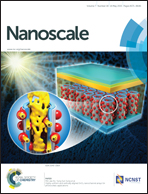Unusual Rh nanocrystal morphology control by hetero-epitaxially growing Rh on Au@Pt nanowires with numerous vertical twinning boundaries†
Abstract
Simultaneously growing multiple nanocrystallites in a crowded space can cause a shortage of precursors, and this can lead to a vertical growth of nanocrystallites on a given substrate. The presence of surfactant–surfactant interactions among adjacent nanocrystals can also place a unique structural constraint on the growing nanocrystallites, resulting in novel nanocrystal facet control. Herein, we report the growth of Rh on Au@Pt nanowires with multiple twinning boundaries, which are found along the entire nanowire length. The Au@Pt nanowires exhibit numerous bead-like structures, resulting from the preferred Pt deposition on the twinning boundaries, which can serve as nucleation sites for Rh. The heteroepitaxial growth of Rh on the Au@Pt nanowires results in unusual crystal growth behaviours. First, novel morphologies of Rh nanorods, nanoplates, and tangled manes are obtained temperature-dependently, which are not obtained in the absence of the Au@Pt nanowire substrate. Secondly, the thickness of vertically grown nanorods and nanoplates is tightly controlled. We also report the structure–catalytic activity relationship on the catalytic hydrogenation of phthalimides by the new Rh nanostructures.


 Please wait while we load your content...
Please wait while we load your content...